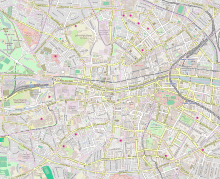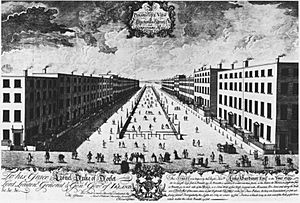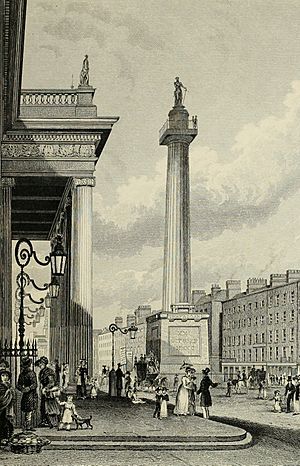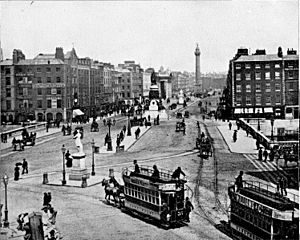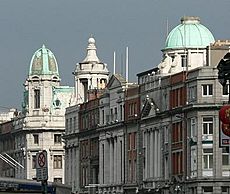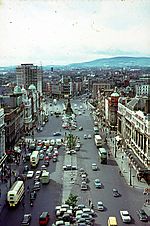O'Connell Street facts for kids
| Sráid Uí Chonaill | |
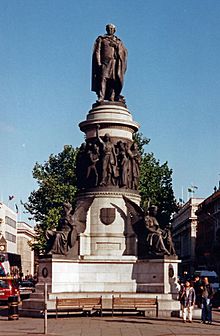
Memorial to 19th-century leader Daniel O'Connell by John Henry Foley, which stands at the entrance to the street
|
|
| Former name(s) | Drogheda Street Sackville Street |
|---|---|
| Length | 0.5 km (0.3 mi) |
| Location | Dublin, Ireland |
| Nearest Tram station | O'Connell Street (Upper), O'Connell Street (GPO) (Luas) |
| Coordinates | 53°20′58″N 6°15′37″W / 53.34944°N 6.26028°W |
| North end | Parnell Street |
| South end | River Liffey |
| Other | |
| Known for | |
O'Connell Street (Irish: Sráid Uí Chonaill) is a very important street in the heart of Dublin, Ireland. It stretches north from the River Liffey. This famous street connects O'Connell Bridge in the south to Parnell Street in the north. It is divided into two main parts by Henry Street. The Luas tram system runs right through the middle of the street.
Back in the 1600s, O'Connell Street was a narrow lane called Drogheda Street. It was named after Henry Moore, the Earl of Drogheda. In the late 1700s, the Wide Streets Commission made the street much wider. They renamed it Sackville Street (Sráid Saicfil). This new name honored Lionel Sackville, 1st Duke of Dorset. In 1924, the street was renamed again. This time, it was named after Daniel O'Connell, a key Irish leader from the early 1800s. You can see his statue at the southern end of the street, looking towards O'Connell Bridge.
This street has played a huge role in Irish history. It has many important statues and monuments. These include statues of Daniel O'Connell and union leader James Larkin. The tall, shiny Spire of Dublin also stands here. O'Connell Street was the setting for big events like the 1913 Dublin lock-out and the 1916 Easter Rising. It also saw action during the Irish Civil War in 1922. Later, Nelson's Pillar was destroyed in 1966, and there were riots in 2006. In recent times, there have been efforts to bring the street back to its grand 1800s look.
Contents
Discovering O'Connell Street's Location
O'Connell Street is on the north side of Dublin city. It goes north from O'Connell Bridge towards Parnell Square. The street is about 600 meters (1,980 feet) long. It is also about 45 meters (150 feet) wide. It has two wide roads on either side. In the middle, there is a pathway with many statues and monuments.
This street used to be part of the N1. This was a main road from Dublin to Belfast. Today, two Luas tram stops are on the street: O'Connell GPO and O'Connell Upper. Many Dublin Bus routes also stop here. This makes it a busy hub for travel across the city.
How O'Connell Street Was Built
O'Connell Street started as Drogheda Street in the 1600s. Henry Moore, 1st Earl of Drogheda planned it. It was only one-third the width of today's O'Connell Street. It ran from Parnell Street to Abbey Street. In the 1740s, a banker named Luke Gardiner bought the upper part of Drogheda Street. He tore down the western side of the street. This created a long, wide residential area. It was about 320 meters (1,050 feet) long and 45 meters (150 feet) wide. This set the size for the modern street.
Many new buildings were built on the western side. The eastern side had grand mansions. Drogheda House was the grandest. It was rented by the sixth Earl of Drogheda. Luke Gardiner also created a mall down the middle of the street. It had low granite walls and obelisks. Trees were planted there a few years later. He named this new area Sackville Street. It was named after Lionel Sackville, 1st Duke of Dorset, who was then the Lord Lieutenant of Ireland. It was also known as 'Sackville Mall' or 'Gardiner's Mall'. Gardiner wanted to connect the new street all the way to the river. But he passed away in 1755. His son, Charles, took over the estate.
Work on the street began in 1757. The city's planning group, the Wide Streets Commission, received money from Parliament. For the next 10 years, they tore down old buildings. They laid out the new road and built new rows of houses. The Wide Streets Commission wanted to create grand, matching buildings from the river. Because of a land dispute, a plot on the northwest remained empty. This later became the General Post Office (GPO). It opened in 1814. The street became very popular when Carlisle Bridge opened. This bridge was designed by James Gandon. It opened in 1792 for walkers and in 1795 for all traffic.
O'Connell Street in the 1800s
Sackville Street thrived in the 1800s. However, there was a difference between the upper and lower parts. Lower Sackville Street became a successful shopping area. Its buildings were designed for shops. This created a contrast: the busy lower end near the river, and the upper end with a mix of smaller businesses and old houses. When William Makepeace Thackeray visited Dublin in 1845, he said the street was "broad and handsome." But he noticed the upper part had less special buildings and fewer visitors.
During the 1800s, Sackville Street changed. It went from a planned design to a street with many unique buildings. One of the world's first department stores was built here. It was Delany's New Mart 'Monster Store', which opened in 1853. The Clery family later bought it. It also had the Imperial Hotel. Across the road, the Hotel Metropole was built next to the GPO. It had a fancy French style. The Gresham Hotel also opened in 1817. It was in two old Georgian houses at the north end of the street. It was later updated as it became more successful.
As the upper part of Sackville Street improved, more businesses opened. These included Turkish baths, which later became part of the Hammam Hotel. Standard Life Assurance built its main Dublin office here. The Findlater family opened a branch of their popular store near Parnell Street. Gilbey's Wine Merchants also opened a shop. The street also became the center of the Dublin tramways system. Many city trams met at the Nelson Pillar. By 1900, Sackville Street was a key place for shopping and business. People even called it "Ireland's Main Street."
During the 1800s, people started calling the street "O'Connell Street." This was seen as its "nationalist" name. The Dublin Corporation wanted to change the name officially in the 1880s. But local residents strongly disagreed. In 1884, they got a court order saying the Corporation could not change the name. The power to change it was given in 1890. But it seems they waited for the new name to become popular. Over time, "O'Connell Street" became widely accepted. The name was officially changed in 1924 without any problems.
Easter Rising and Irish Independence
On August 31, 1913, O'Connell Street saw a terrible event during the Dublin lock-out. This was a big fight between workers and the police. During a speech by workers' rights leader James Larkin, police rushed into the crowd and arrested him. The crowd then started a riot. This led to two deaths, 200 arrests, and many injuries.
During the Easter Rising in 1916, Irish republicans took over the General Post Office. They then declared the Irish Republic. This led to the street being bombed for several days. The gunboat Helga from the Royal Navy fired on the street. Other cannons were also brought in to shoot at the north end. There was also a lot of gunfire and sniper attacks from nearby areas. By Saturday, the rebels had to leave the burning GPO. They held out on Moore Street until they surrendered.
Much of the street was destroyed. The entire eastern side was ruined, up to Cathedral Street. The buildings between the GPO and Abbey Street on the western side were also damaged. During the chaos of the rebellion, people from nearby poor areas looted many shops on O'Connell Street. These events badly hurt the businesses in the city center. The damage was about £2.5 million. Some businesses stayed closed until 1923 or never reopened.
After the Rising, the Dublin Reconstruction Act was created in 1916. Its goal was to control how the area was rebuilt. The idea was to rebuild in a planned and grand way. This was also a chance to make businesses more modern. Under this law, the city had to approve all construction. They could reject anything that did not fit the street's style. City Architect Horace T. O'Rourke oversaw the rebuilding. Except for its front and entrance, the General Post Office was destroyed. A new GPO was built behind the old 1818 front. Work started in 1924. The Henry Street side was built first. It had new shops at street level. There was also a public shopping area linking to Princes Street. New offices were on the upper floors. The main public office on O'Connell Street reopened in 1929.
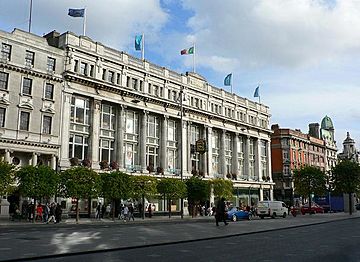
O'Connell Street saw another fierce battle in July 1922. This was at the start of the Irish Civil War. Anti-treaty fighters led by Oscar Traynor took over the street. This happened after pro-treaty Irish National Army troops attacked the republican base in the nearby Four Courts. The fighting lasted from June 28 to July 5. National Army troops used cannons at close range. They were protected by armored cars. They bombed the buildings held by the republicans. Cathal Brugha was among those who died. The fighting mostly affected the northern end of the street. Most of the buildings north of Cathedral Street to Parnell Square were destroyed. A few buildings on the northwest side were also ruined. In total, about three-quarters of the buildings on the street were destroyed or torn down between 1916 and 1922. Because of this, only one old Georgian house remains on the street today.
Because of the huge destruction and rebuilding, most buildings on O'Connell Street are from the early 1900s. The only original building left is No. 42. The Royal Dublin Hotel has owned it since 1972. This house was once home to Robert Robinson. He was a doctor for the State and a professor at Trinity College. Later, it was Daniel O'Connell's Catholic Commercial Club. The building dates back to 1752. It was designed by Richard Cassels. There were plans to add the house to the hotel in 1975 and 1978. But this work was never done. In 1982, permission was asked to tear down the house, but it was refused. Besides the GPO, other important buildings rebuilt after the fighting include the department store Clerys. It reopened in August 1922. The Gresham Hotel also reopened in 1927.
Modernizing O'Connell Street
Even with the rebuilding after 1916-1922, the street later suffered from poor planning. Like many parts of Dublin then, property developers were allowed to build unsuitable buildings. This often meant tearing down historic properties. This happened even though the area was protected. Journalist Frank McDonald believes the street's decline began when Nelson's Pillar was blown up. He says losing the pillar made the area lose its special character. The pillar was also a major landmark, a meeting spot, and a popular tourist attraction.
Several old Victorian and 1920s buildings were torn down in the 1960s and 1970s. One early example was the demolition of two house fronts by CIÉ in 1961. This made way for a new passenger information office. The new building has a glass wall with stained glass by Evie Hone. Another building torn down was Gilbey's at the north end of the street. This building had a fancy Victorian Romanesque front. It also had a porch and a decorated roof. It was torn down in March 1973. Two stone heads of Gladstone and Palmerston were saved. They were placed above the new entrance. This building was meant for shops and offices. But Dublin City Council rented the whole building from 1975. They then made the ground floor a sound-proof council meeting room.
The Metropole and Capitol cinemas next to the GPO were torn down in 1973. McDonald noted this removed the main social center of O'Connell Street. These places were not just cinemas. The Capitol had lounges, meeting rooms, cafes, and a restaurant. The Metropole had a ballroom, restaurants, and bars. The site was cleared and rebuilt for British Home Stores. It stayed there until 1992 when it closed. A branch of Penney's then took over. Findlater's grocery and wine shop on the corner of O'Connell Street and Cathal Brugh Street was torn down in 1972. It was replaced with a five-story office building with shops on the ground floor. This is one of the newer buildings that changed the street's careful design from the 1920s.
Numbers 40 and 41 were among the last original Wide Streets Commission buildings from the 1780s. They were torn down in 1968 for the Royal Dublin Hotel. Designed by Patrick Carr, it was the first hotel built in Dublin since the Gresham in the 1920s. It opened in 1970. This hotel was also torn down after it closed in 2008. It has been an empty site since then. Along with the empty site next to the former Carlton Cinema, and the Carlton itself, there are plans to build a large shopping center. This center would connect to Moore Street. This "Carlton site" covers almost six acres. It faces O'Connell, Moore, Parnell, and Henry Streets. The empty site next to the Carlton was Gill's bookshop and a Penney's store until 1979. The Bank of Ireland bought it then. Gill's was destroyed by fire while empty. It later collapsed in September 1979. Both buildings were then leveled. Many older buildings were replaced with fast-food restaurants, shops, and offices. These are still the main features of O'Connell Street today.
Dublin City Council created the O'Connell Street Integrated Area Plan (IAP) in 1998. The goal was to bring the street back to its former glory. The plan aimed for more than just cosmetic changes. It wanted to control the wider area, including how people and vehicles interact. It also focused on managing and protecting the architecture. Work on the plan was delayed. It was finally approved in June 2003.
The main parts of the plan included wider footpaths and less road space. All trees were removed and replaced. A new plaza was built in front of the GPO. New street furniture was added, like custom lampposts, bins, and kiosks. The plan also included the Spire of Dublin project. This is Dublin's tallest sculpture. It was built between December 2002 and January 2003. It stands where Nelson's Pillar used to be. Many monuments were restored. These included statues of Charles Stewart Parnell, Jim Larkin, and Sir John Grey. The most challenging was restoring the O'Connell Monument. This project took months for experts to complete. It was unveiled in May 2005.
All public works were finished in June 2006. This completed the main goal of the IAP. It cost €40 million. The loss of old trees during this work has been noted. It made the problems with the street's appearance even more obvious. Work was interrupted by a riot on February 25, 2006. A protest against a planned march turned into vandalism and looting. Building materials from the ongoing work were used as weapons. They were also used to smash windows and fixtures.
O'Connell Street is now a special area. It is called an Architectural Conservation Area and an Area of Special Planning Control. This means no buildings can be changed without Dublin City Council's permission. Fast food places, takeaways, cafes, and arcades are strictly controlled.
In June 2015, Clerys department store suddenly closed. This happened after an investment group bought it. Over 400 jobs were lost. In 2019, plans were announced to turn the building into a four-star hotel.
The street is used as the main route for the annual St. Patrick's Day Parade. It is also the setting for the 1916 Commemoration every Easter Sunday. It is a major bus route through the city center. The modern tram, the Luas, has been extended. Trams now run through O'Connell Street again. It only travels in one direction. The return loop, which connects to St. Stephen's Green, runs via Marlborough Street. This street is parallel to and east of O'Connell Street.
Famous Statues on O'Connell Street
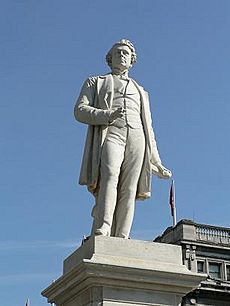
Here are some of the statues you can see on O'Connell Street, from south to north:
- Daniel O'Connell: This statue was designed by John Henry Foley. His assistant, Thomas Brock, finished it. Work started in 1866, and the statue was revealed in 1883.
- William Smith O'Brien: This statue was made by Thomas Farrell. It was first put up in 1870 near O'Connell Bridge. It was moved to O'Connell Street in 1929.
- Sir John Gray: Also by Thomas Farrell. Both the base and the statue are made of white Sicilian marble. It was unveiled in 1879. Gray owned the Freeman's Journal newspaper. He also helped build Dublin's water supply system from the Vartry Reservoir.
- James Larkin: This is a bronze statue on a Wicklow granite base. It was made by Oisín Kelly. The monument was unveiled in 1980.
- Anna Livia: Created by Eamonn O'Doherty. This granite sculpture was unveiled on June 17, 1988. It quickly became known as "The Floosy in the Jacuzzi." It was moved in 2001 for O'Connell Street's rebuilding. In 2011, it moved to the Croppies' Acre Memorial Park.
- Nelson's Pillar: This tall granite column was 36.8 meters (121 feet) high. It was built in 1808 to honor Admiral Lord Nelson. It used to stand in the center of the street. This is where the Spire of Dublin is now. Republican activists blew it up in 1966. The site was empty until the Spire was built in 2003.
- Father Theobald Mathew: This statue was made by Mary Redmond. The first stone was laid in 1890, and the monument was unveiled in 1893. In 2016, the statue was moved. This was to make way for the Luas tram extension.
- Charles Stewart Parnell: This is the Parnell Monument. It was made by Irish-American sculptor Augustus Saint-Gaudens. The 37-foot-high obelisk sits on a Galway granite base. John Redmond organized it, and people paid for it. It was unveiled in 1911. It is at the junction with Parnell Street, just south of Parnell Square.
See also
 In Spanish: Calle O'Connell para niños
In Spanish: Calle O'Connell para niños


